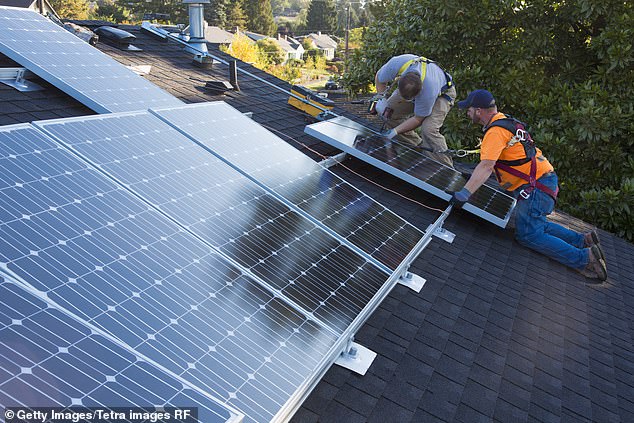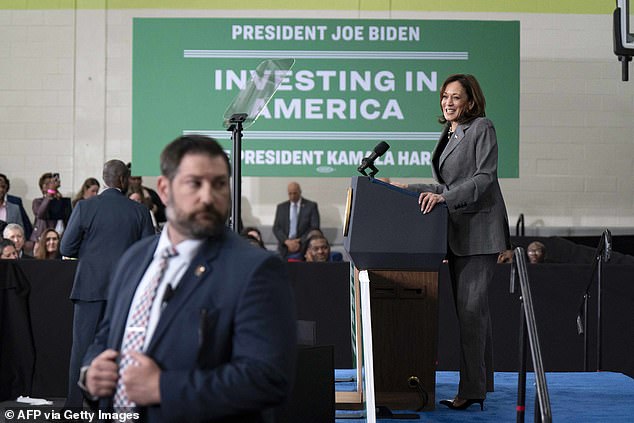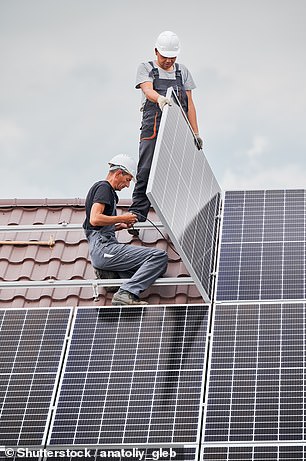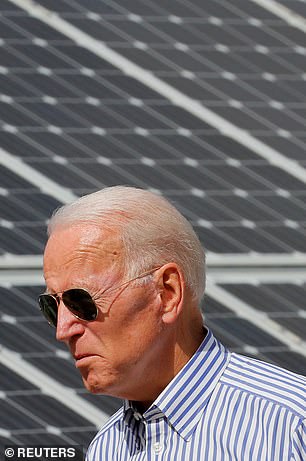Biden unveils $20 billion in green energy spending that he says will cut 44 million tons of carbon every year — but Republicans see it as a taxpayer-funded ‘slush fund’
Eight groups will receive tens of billions in taxpayer money, the Biden White House announced today, in an effort to help struggling Americans reduce their carbon emissions.
The $20 billion was awarded Thursday by the Environmental Protection Agency in the form of federal “green bank” grants to eight community development banks and nonprofits for use in low-income communities that lack the resources to modernize.
But Republicans in Congress labeled the funding a taxpayer-funded “slush fund” intended to support the Biden administration’s “special interest friends.”
This spending, these lawmakers argued, risks delivering billions of dollars to China, which “controls the components needed for renewable energy,” all in service of an effort they describe as a “radical rush to a green agenda.”
Eight groups will receive tens of billions in taxpayer money, the Biden White House announced today, in an effort to help struggling Americans reduce their carbon emissions. Vice President Kamala Harris traveled to Charlotte, North Carolina on Thursday to unveil the funds (photo)

Republicans in Congress labeled the funding a “slush fund” intended to support the Biden administration’s “special interest friends.” One recipient, Appalachian Community Capital, said it plans to use its $500 million grant to “help communities impacted by coal succeed.”
At least $14 billion of the $20 billion, according to the EPAwill be reserved for economically disadvantaged communities, including rural, urban and tribal areas, as well as so-called “energy communities,” including cities with closed coal mines.
The nonprofit community bank Appalachian Community Capital, which will receive $500 million from the fund, said it plans to “help communities impacted by coal succeed.”
The president of the bank Donna Gambrell specified that the grant will go toward “investments and technical assistance,” with the Appalachian bank planning to fund “workforce development,” meaning job training for a local post-coal economy.
Last month, West Virginia’s governor vetoed a bipartisan bill from his state House that would have added 50 megawatts of solar power to Appalachia.
As proposed by the Biden administration, these tens of billions in subsidies would go toward low-cost loans issued by the select nonprofit banks to jump-start local, environmentally sustainable businesses that promise to be economically profitable.
“While every community has the capacity to participate in the clean energy economy,” said Vice President Kamala Harris, “not every community has had the opportunity.”
Harris traveled to Charlotte, North Carolina on Thursday to reveal the money.
“With this approach, we have the ability to empower communities to decide which projects they want that, from their perspective, will have the greatest impact on the place they call home,” the vice president said.
But critics of the program from the Republican-controlled House Energy and Commerce Committee claimed the funding was “ripe for waste, fraud and abuse.”
Instead of local communities, the biggest beneficiary would be China, House Republicans argued in their press statement.
While the United States currently produces a third of its solar panels domestically, it faces stiff competition from China – which according to figures produces 98 percent of the world’s solar wafers. Reuters.

Republicans in Congress labeled the funding a taxpayer-funded “slush fund.” They argued that the subsidies risk sacrificing billions of dollars to China, which “controls the components needed for renewable energy,” adding that the Asian country is “one of our biggest adversaries.”


While the US currently produces a third of its solar panels domestically, the country faces stiff competition from China – which produces 98 percent of the world’s solar wafers, according to Reuters. Today, the US imposes a 39 percent tariff on solar energy components imported from China
“By mandating technologies that rely entirely on resources from China,” the Republican lawmakers said, “the president is taking taxpayer dollars and using them to line the pockets of one of our greatest adversaries.”
However, President Biden’s initiative has also lined the pockets of the US domestic solar industry federal tax credits for domestic solar panel manufacturers.
Thursday’s announcement about the “green bank” financing was approved by Congress earlier in 2022 as part of the Inflation Reduction Act (IRA), in addition to billions in subsidies and tax breaks for the U.S. domestic solar industry.
“The IRA subsidies are hugely lucrative, but they are still not enough to compete with cheap imports,” Pol Lezcano, a senior analyst at BloombergNEF, told the newspaper. Financial times.
Lezcano believed that a “new protectionist measure” would be necessary to make American solar energy production competitive against Chinese dominance.
Today, the US already imposes a 14 percent tariff on imported solar components from most countries – while Chinese imports face an additional 25 percent tariff.
Until last June, when Biden imposed a moratorium, the US had imposed a 200 percent duty on Chinese solar panels in an effort to counter what the Financial Times described as China’s attempts to crush its aspiring US competitors with a flood of cheap solar -energy, to thwart.
“(China) doesn’t want the US to have its own domestic industry. . . It’s a pretty dire situation,” Mark Widmar, CEO of First Solar, America’s largest solar manufacturer, told the business newspaper.
The $20 billion in nonprofit bank grants, officially called the Greenhouse Gas Reduction Fund, specifically mandates financing exclusively for solar projects.
However, another $7 billion will be awarded this spring under the GGRF’s “Solar for All” program, officials said.
Concerns about the rapid pace of climate change have reached a fever pitch in the past year, with dire warnings of “mega-hurricanes” and the resurgence of ancient diseases such as the plague, according to a US government-funded study.
The United Nations World Meteorological Organization (WMO) reported that several climate records were broken and in some cases ‘shattered’ last year.
Greenhouse gas levels, surface temperatures, ocean heat and acidification, sea level rise and ice loss in Antarctica will all escalate by 2023 due to fossil fuel emissions, their report warned.
“Sirens are sounding on all major indicators,” said United Nations Secretary-General António Guterres.
“Some records don’t just top the charts, they break the charts – and the changes are accelerating.”
